Enhancing Architectural Education through Artificial Intelligence: A Case Study of an AI-Assisted Architectural Programming and Design Course
Abstract
1. Introduction
2. Background
2.1. Evolutionary Goals of Architectural Education
2.2. Significance of Architectural Programming
2.3. AI Technologies in Architectural Education
3. Course Model of AI-Assisted Architectural Programming and Design
3.1. Theoretical Framework
3.2. Teaching Process
3.3. Method Steps
4. Case Study
4.1. Course Background
4.2. Course Outcomes
4.3. Survey Methodology
5. Results
5.1. Positive Impact of AI-Assisted Architectural Programming and Design Teaching Model
5.2. Innovation Ability and Work Efficiency as Key Factors Influencing the Teaching Model
5.3. Tight Integration of AI Technologies with Architectural Programming but Unpredictable Outcomes in Architectural Design
5.4. AI Mainly Focuses on Point Interventions and Has Not Formed Comprehensive and Systematic Coverage Currently
6. Discussion
6.1. Balancing the Usability and Stability of AI in Architectural Programming and Design
6.2. Further Enhancing the Ubiquity and Acceptance of AI Technologies
6.3. Multi-Domain Integration Development of AI Technologies
7. Conclusions
Supplementary Materials
Author Contributions
Funding
Institutional Review Board Statement
Informed Consent Statement
Data Availability Statement
Acknowledgments
Conflicts of Interest
Appendix A
| 1. Demographical Characteristics | |||||||
| 1.1 Your Name: | |||||||
| 1.2 Your Gender: | |||||||
| 1.3 Your Grade: | |||||||
| 1.4 Your University: | |||||||
| 1.5 Your Group: | |||||||
| 2. Teaching Model Evaluation Scale | |||||||
| □1: Completely disagree □2: Disagree □3: Neutral □4: Agree □5: Strongly agree | |||||||
| Categories | Questions | ||||||
| Perceived Usefulness (PU) | PU1: AI tools have strong information sorting ability. | ||||||
| PU2: AI tools have strong decision-making ability. | |||||||
| PU3: AI tools have strong logical analysis ability. | |||||||
| PU4: AI tools have strong innovative thinking ability. | |||||||
| PU5: AI tools have strong design expression ability. | |||||||
| PU6: AI tools have strong transferability. | |||||||
| Perceived Ease of Use (PEU) | PEU1: AI tools have a clear theoretical framework. | ||||||
| PEU2: AI tools have a simple operational process. | |||||||
| PEU3: AI tools have convenient resource access. | |||||||
| PEU4: AI tools’ model fine-tuning is easy. | |||||||
| PEU5: AI tools have high working efficiency. | |||||||
| PEU6: AI tools have high compatibility. | |||||||
| Attitudes Toward Using (ATU) | ATU1: I prefer using AI tools in the architectural programming stage. | ||||||
| ATU2: I like using AI tools for brainstorming in the architectural programming stage. | |||||||
| ATU3: I like using AI tools for data analysis in the architectural programming stage. | |||||||
| ATU4: I prefer using AI tools in the architectural design stage. | |||||||
| ATU5: I like using AI tools for inspiration in the architectural design stage. | |||||||
| ATU6: I like using AI tools to complete design outcomes in the architectural design stage. | |||||||
| 3. Teaching Model Descriptive Statistics | |||||||
| 3.1 Before this course, have you used any AI tools in your studies? | |||||||
| □Never before | □1–2 times | □Occasional use | □Frequent use | ||||
| 3.2 In this course, in which phase do you use AI tools? (Multiple choices) | |||||||
| □Problem-seeking phase | □Decision phase | □Design phase | □Expression phase | ||||
| 3.3 In this course, how often do you use AI tools in each class? | |||||||
| □1–2 times | □3–5 times | □8–10 times | □More than 10 times | ||||
| 3.4 After this course, will you continue to use AI tools? | |||||||
| □Absolutely not | □Probably not | □Occasionally | □Certainly | ||||
| Categories | Questions | ||||||
| general AI (e.g., ChatGPT) | In this course, at which stage do you use this category of AI tools? | ||||||
 | |||||||
| How often do you use this category of AI tools in this course? | |||||||
| □Never | □1–2 times | □3–5 times | □Always | ||||
| design-assistive AI (e.g., Stable Diffusion) | In this course, at which stage do you use this category of AI tools? | ||||||
 | |||||||
| How often do you use this category of AI tools in this course? | |||||||
| □Never | □1–2 times | □3–5 times | □Always | ||||
| expression-assistive AI (e.g., Midjourney and DALL-E) | In this course, at which stage do you use this category of AI tools? | ||||||
 | |||||||
| How often do you use this category of AI tools in this course? | |||||||
| □Never | □1–2 times | □3–5 times | □Always | ||||
| 4. Overall Evaluation of the Teaching Model | |||||||
| □1: Completely disagree □2: Disagree □3: Neutral □4: Agree □5: Strongly agree | |||||||
| 4.1 This course has been very effective for my learning. | |||||||
| 5. Open-ended Questions | |||||||
| 5.1 Share your thoughts on this teaching model with us. | |||||||
Appendix B
| 1. Users’ Views on the Involvement of AI in Architectural Education |
| 1.1 Reasons for agreeing with the integration of AI into architectural education, citing examples from practical applications. |
| 1.2 Reasons for disagreeing with the integration of AI into architectural education, citing examples from practical applications. |
| 1.3 Views on the future development of AI in architectural education. |
| 1.4 Additional comments. |
| 2. Methods in Which Users Utilize AI in Assisting Architectural Programming and Design |
| 2.1 Frequency and effectiveness of using AI tools. |
| 2.2 Views on different types of AI tools, such as universal AI, design-assist AI, and expression-assist AI. |
| 2.3 Challenges encountered during the process of using AI in architectural programming and design. |
| 2.4 Additional comments. |
| 3. Specific Features of AI Tools that Influence Architectural Education |
| 3.1 How these features affect your work in architectural programming and design, with examples from practical applications. |
| 3.2 Whether you believe these features of AI tools have a positive impact, with examples from practical applications. |
| 3.3 Identified shortcomings of AI tools, with examples from practical applications. |
| 3.4 Additional comments. |
| 4. Users’ Satisfaction with the Application of AI Tools |
| 4.1 Satisfaction with the use of AI tools in architectural education, with examples from practical applications. |
| 4.2 Satisfaction with the use of AI tools in the architectural programming phase, with examples from practical applications. |
| 4.3 Satisfaction with the use of AI tools in the architectural design phase, with examples from practical applications. |
| 5. Users’ Needs and Preferences for the Application of AI Tools in Architectural Education |
| 5.1 Demands and suggestions for using AI tools in architectural programming and design. |
| 5.2 Preferences for the future development of AI tools in architectural programming and design. |
| 5.3 Additional comments. |
References
- Zawacki-Richter, O.; Marin, V.I.; Bond, M.; Gouverneur, F. Systematic review of research on artificial intelligence applications in higher education—Where are the educators? Int. J. Educ. Technol. High. Educ. 2019, 16, 39. [Google Scholar] [CrossRef]
- Hinojo-Lucena, F.J.; Aznar-Díaz, I.; Cáceres-Reche, M.P.; Romero-Rodríguez, J.M. Artificial Intelligence in Higher Education: A Bibliometric Study on its Impact in the Scientific Literature. Educ. Sci. 2019, 9, 51. [Google Scholar] [CrossRef]
- Delello, J.A.; Sung, W.; Mokhtari, K.; De Giuseppe, T. Are K-16 educators prepared to address the educational and ethical ramifications of artificial intelligence software? In Proceedings of the Future of Information and Communication Conference (FICC) 2024, Lecture Notes in Networks and Systems, Berlin, Germany, 4–5 April 2024.
- Grierson, D.; Munro, K. Transformative Learning Methods in Interdisciplinary Postgraduate Education for Sustainable Development (ESD). Archnet-IJAR 2018, 12, 209–227. [Google Scholar] [CrossRef]
- Martínez-Ventura, J.; De-Miguel-Arbonés, E.; Sentieri-Omarrementería, C.; Galan, J.; Calero-Llinares, M. A Tool to Assess Architectural Education from the Sustainable Development Perspective and the Students’ Viewpoint. Sustainability 2021, 13, 9596. [Google Scholar] [CrossRef]
- Basarir, L. Modelling AI in Architectural Education. Gazi Univ. J. Sci. 2022, 35, 1260–1278. [Google Scholar] [CrossRef]
- Senyapili, B.; Basa, I. The shifting tides of academe: Oscillation between hand and computer in architectural education. Int. J. Technol. Des. Educ. 2006, 16, 273–283. [Google Scholar] [CrossRef]
- Daemei, A.B.; Safari, H. Factors affecting creativity in the architectural education process based on computer-aided design. Front. Archit. Res. 2018, 7, 100–106. [Google Scholar] [CrossRef]
- Holzer, D. Design exploration supported by digital tool ecologies. Autom. Constr. 2016, 72, 3–8. [Google Scholar] [CrossRef]
- Abdullah, H.K.; Hassanpour, B. Digital design implications: A comparative study of architecture education curriculum and practices in leading architecture firms. Int. J. Technol. Des. Educ. 2021, 31, 401–420. [Google Scholar] [CrossRef]
- Alalouch, C. A Pedagogical Approach to Integrate Parametric Thinking in Early Design Studios. Archnet-IJAR 2018, 12, 162–181. [Google Scholar] [CrossRef]
- Monedero, J. Parametric design: A review and some experiences. Autom. Constr. 2000, 9, 369–377. [Google Scholar] [CrossRef]
- As, I.; Pal, S.; Basu, P. Artificial intelligence in architecture: Generating conceptual design via deep learning. Int. J. Archit. Comput. 2018, 16, 306–327. [Google Scholar] [CrossRef]
- Brunetti, G.L. Evolutionary trends in the use of artificial intelligence in support of architectural design. TECHNE-J. Technol. Archit. Environ. 2023, 25, 55–60. [Google Scholar] [CrossRef]
- Qian, W.L.; Yang, F.; Mei, H.Y.; Li, H. Artificial intelligence-designer for high-rise building sketches with user preferences. Eng. Struct. 2023, 275, 115171. [Google Scholar] [CrossRef]
- Hu, Y. Promoting the Implementation of Architect Responsibility System to Drive High-Quality Urban Development. China Explor. Des. 2023, 4, 24–27. (In Chinese) [Google Scholar]
- Xu, Q.; Zhuang, W.; Li, C. Actively Promoting the Pilot Implementation of the Architect Responsibility System to Facilitate High-Quality Development of the Capital City. China Explor. Des. 2021, 9, 14–17. (In Chinese) [Google Scholar]
- Liang, S. Exploring Teaching Practices in Architectural Design Courses Based on the “Pre-planning-Post-evaluation” Ap-proach. Resid. Zone 2019, 3, 44–49. (In Chinese) [Google Scholar]
- Bibbings, H.; Bieluga, P.A.; Mills, C. Enhancing Creativity and Independent Learning of Architectural Technology Students through the Use of A Real Life Design Competition Module. Archnet-IJAR 2018, 12, 376–387. [Google Scholar] [CrossRef]
- Oliveira, S.; Griffin, E.; Cash, D.; Marco, E. Health and wellbeing in design studio briefs—Architecture and engineering graduating students’ motivations and approaches. Build. Serv. Eng. Res. Technol. 2020, 41, 137–152. [Google Scholar] [CrossRef]
- Liu, M. Analysis of Factors Influencing the Curriculum of “Architectural Programming” and Study on Adaptive Teaching Strategies in Architectural Major Courses. Resid. Zone 2019, 3, 33–43. (In Chinese) [Google Scholar]
- Tu, H.; Zhao, Y. Participatory Architectural Design Teaching Based on Interaction with People—Exploration of Architectural Programming Methods in Architectural Design Teaching. S. Archit. 2017, 5, 24–29. (In Chinese) [Google Scholar]
- Tu, H.; Li, W.; Zhou, C.; Tang, P. Research on Theoretical Intervention of Architectural Programming in Urban Design Courses Based on Multiple Subject Participation. China Archit. Educ. 2020, 1, 52–58. (In Chinese) [Google Scholar]
- Pelletier, K.; Robert, J.; Muscanell, N.; McCormack, M.; Reeves, J.; Arbino, N.; Grajek, S.; Birdwell, T.; Liu, D.; Mandernach, J.; et al. 2023 Educause Horizon Report, Teaching and Learning Edition. Available online: https://library.educause.edu/resources/2023/5/2023-educause-horizon-report-teaching-and-learning-edition?utm_source=Selligent&utm_medium=email&utm_campaign=report_hz_tl&utm_content=05-08-23-a&utm_term=_&m_i=7YUj6b8FjpCuZhPGNoCS59kpPEGjUZcXMsh8YTtd8ww10EE2rTyKcGa4Fsloy7QxczTYMPOX6jqtETK6MWI3eRTdHhSOZ5l77Z&M_BT=32218515346 (accessed on 11 November 2023).
- Charalambous, N.; Christou, N. Re-adjusting the objectives of Architectural Education. In Proceedings of the 2nd International Conference on Higher Education Advances, Head’16, Valencia, Spain, 2016; Domenech, J., VincentVela, M.C., PenaOrtiz, R., DeLaPoza, E., Blazquez, D., Eds.; Volume 228, pp. 375–382. [Google Scholar]
- Tokman, L.Y.; Yamacli, R. Reality-based design studio in architectural education. J. Archit. Plan. Res. 2007, 24, 245–269. [Google Scholar]
- Ünay, A.I.; Özmen, C. Building structure design as an integral part of architecture: A teaching model for students of architecture. Int. J. Technol. Des. Educ. 2006, 16, 253–271. [Google Scholar] [CrossRef]
- Uzunoglu, S.S. Aesthetics and Architectural Education. In Proceedings of the World Conference on Design, Arts And Education (DAE-2012), Antalya, Turkey, 2012; Ilhan, A.C., Ed.; Volume 51, pp. 90–98. [Google Scholar]
- Danaci, H.M. Aesthetics in Cultural Landscape and Architectural Education. In Proceedings of the 6th World Conference on Educational Sciences, Milan, Italy, 2015; Uzunboylu, H., Ed.; Volume 191, pp. 190–195. [Google Scholar]
- Danaci, H.M. Creativity and knowledge in architectural education. In Proceedings of the International Conference on New Horizons in Education, Inte 2014, Prague, Czech Republic, 2015; Iaman, A., Eskicumali, A., Eds.; Volume 174, pp. 1309–1312. [Google Scholar]
- Wu, S.S. Design/Build Teaching Practice in Architectural Design Basic Course Based on CDIO Mode. In Proceedings of the 2015 3rd International Conference on Education Reform and Management Innovation (ERMI 2015), PT 2, Boston, MA, USA, 2015; Lee, G., Ed.; Volume 79, pp. 50–54. [Google Scholar]
- Djabarouti, J.; O’Flaherty, C. Experiential learning with building craft in the architectural design studio: A pilot study exploring its implications for built heritage in the UK. Think. Ski. Creat. 2019, 32, 102–113. [Google Scholar] [CrossRef]
- Yurtsever, B.; Cakir, G. An assessment for interdisciplinary education modal implementation of basic design education in architecture. In Proceedings of the World Conference on Design, Arts and Education (DAE-2012), Antalya, Turkey, 2012; Ilhan, A.C., Ed.; Volume 51, pp. 157–161. [Google Scholar]
- Ivarsson, J. Developing the construction sight: Architectural education and technological change. Vis. Commun. 2010, 9, 171–191. [Google Scholar] [CrossRef]
- Abu Alatta, R.; Freewan, A. Investigating the Effect of Employing Immersive Virtual Environment on Enhancing Spatial Perception within Design Process. Archnet-IJAR 2017, 11, 219–238. [Google Scholar] [CrossRef]
- Coleman, N. The Limits of Professional Architectural Education. Int. J. Art Des. Educ. 2010, 29, 200–212. [Google Scholar] [CrossRef]
- Djokic, V.; Nikezic, A.; Jankovic, N. Learning from the Landscape Toward Socially Responsible Architectural Education. In Proceedings of the 2013 International Conference on the Modern Development of Humanities and Social Science, Hong Kong, China, 1–2 December 2013; Chou, T., Ed.; pp. 166–169. [Google Scholar]
- Ismail, M.A.; Keumala, N.; Dabdoob, R.M. Review on integrating sustainability knowledge into architectural education: Practice in the UK and the USA. J. Clean. Prod. 2017, 140, 1542–1552. [Google Scholar] [CrossRef]
- Taleghani, M.; Ansari, H.R.; Jennings, P. Sustainability in architectural education: A comparison of Iran and Australia. Renew. Energy 2011, 36, 2021–2025. [Google Scholar] [CrossRef]
- Agirbas, A. Teaching construction sciences with the integration of BIM to undergraduate architecture students. Front. Archit. Res. 2020, 9, 940–950. [Google Scholar] [CrossRef]
- Szewczenko, A. Enhancing the Students’ Competences Using the Action Research Method: Architecture Education towards Ageing Society. In Proceedings of the Inted2017: 11th International Technology, Education and Development Conference, Valencia, Spain, 6–8 March 2017; Chova, L.G., Martinez, A.L., Torres, I.C., Eds.; pp. 3495–3501. [Google Scholar]
- Ceylan, S.; Soygenis, M.D. A design studio experience: Impacts of social sustainability. Archnet-IJAR 2019, 13, 368–385. [Google Scholar] [CrossRef]
- Taleghani, M.; Ansari, H.R.; Jennings, P. Renewable energy education in sustainable architecture: Lessons from developed and developing countries. Energy Educ. Sci. Technol. Part B-Soc. Educ. Stud. 2010, 2, 111–131. [Google Scholar]
- Boarin, P.; Martinez-Molina, A.; Juan-Ferruses, I. Understanding students’ perception of sustainability in architecture education: A comparison among universities in three different continents. J. Clean. Prod. 2020, 248, 119237. [Google Scholar] [CrossRef]
- Maturana, B.; Salama, A.M.; McInneny, A. Architecture, urbanism and health in a post-pandemic virtual world. Archnet-IJAR 2021, 15, 1–9. [Google Scholar] [CrossRef]
- Zhuang, W.; Miao, Z.; Guo, S.; Zheng, Y.; Gao, X. Research on the frontier trend of architectural programming and postoccupancy evaluation intelligent technology. Sci. Sin. Technol. 2023, 53, 704–712. [Google Scholar] [CrossRef]
- He, W.Y. From Competition, Coexistence to Win-Win—Relationship between Intelligent Design Tools and Human Designers. Landsc. Archit. Front. 2019, 7, 76–83. [Google Scholar] [CrossRef]
- Yuan, P.F.; Beh, H.S.; Yang, X.Z.; Zhang, L.M.; Gao, T.Y. Feasibility study of large-scale mass customization 3D printing framework system with a case study on Nanjing Happy Valley East Gate. Front. Archit. Res. 2022, 11, 670–680. [Google Scholar] [CrossRef]
- Kelly, J.; Duerk, D. Construction project briefing/architectural programming. In Best Value in Construction; Blackwell Science Ltd.: Hoboken, NJ, USA, 2002; pp. 38–58. [Google Scholar]
- Hershberger, R. Architectural Programming and Predesign Manager; Routledge: London, UK, 2015. [Google Scholar]
- Pena, W.M.; Parshall, S.A. Problem Seeking: An Architectural Programming Primer, 5th ed.; John Wiley and Sons: Hoboken, NJ, USA, 2012; p. 288. [Google Scholar]
- Zhuang, W. Development and Prospects of Architectural Programming and Post-Evaluation Education. Resid. Zone 2019, 3, 6–7. (In Chinese) [Google Scholar]
- Zhang, W.; Zhuang, W. Comparative Analysis of Architectural Programming Education in China and the United States. New Archit. 2008, 5, 111–114. (In Chinese) [Google Scholar]
- She, Y.I.; Wang, M.I.; Wang, N.I.; Wang, M.E.; Zhang, A.T.; Jacobs, S.T.; Zhuang, W. Reflections and Improvements on Architectural Programming: Programming and Post- Occ upancy Evaluation to Whole-Process Consultation. Landsc. Archit. Front. 2017, 5, 62–67. [Google Scholar]
- Gray, C.F.; Larson, E.W. Project Management: The Managerial Process, 5th ed.; McGraw-Hill: New York, NK, USA, 2011; p. 574. [Google Scholar]
- Blyth, A.; Worthington, J. Managing the Brief for Better Design, 2nd ed.; Routledge: London, UK, 2010; p. 296. [Google Scholar]
- Zhang, B.; Zhu, J.; Su, H. Toward the third generation of artificial intelligence. Sci. Sin. Informationis 2020, 50, 1281–1302. [Google Scholar] [CrossRef]
- Hansen, L.K.; Salamon, P. Neural Network Ensembles. Ieee Trans. Pattern Anal. Mach. Intell. 1990, 12, 993–1001. [Google Scholar] [CrossRef]
- Schmidhuber, J. Deep learning in neural networks: An overview. Neural Netw. 2015, 61, 85–117. [Google Scholar] [CrossRef] [PubMed]
- Mnih, V.; Kavukcuoglu, K.; Silver, D.; Rusu, A.A.; Veness, J.; Bellemare, M.G.; Graves, A.; Riedmiller, M.; Fidjeland, A.K.; Ostrovski, G.; et al. Human-level control through deep reinforcement learning. Nature 2015, 518, 529–533. [Google Scholar] [CrossRef] [PubMed]
- Zhao, W.X.; Zhou, K.; Li, J.; Tang, T.; Wang, X.; Hou, Y.; Min, Y.; Zhang, B.; Zhang, J.; Dong, Z.; et al. A Survey of Large Language Models. arXiv 2023, arXiv:2303.18223. [Google Scholar] [CrossRef]
- Wu, J.; Gan, W.; Chen, Z.; Wan, S.; Lin, H. AI-Generated Content (AIGC): A Survey. arXiv 2023, arXiv:2304.06632. [Google Scholar] [CrossRef]
- Caldas, L.G.; Norford, L.K. A design optimization tool based on a genetic algorithm. Autom. Constr. 2002, 11, 173–184. [Google Scholar] [CrossRef]
- Liu, R.; Jiang, D.; Shi, L. Agent-based simulation of alternative classroom evacuation scenarios. Front. Archit. Res. 2016, 5, 111–125. [Google Scholar] [CrossRef]
- Lobos, D.; Donath, D. The problem of space layout in architecture: A survey and reflections. Arquitetura Rev. 2010, 6, 136–161. [Google Scholar] [CrossRef]
- Chatzikonstantinou, I.; Sariyildiz, S. Approximation of simulation-derived visual comfort indicators in office spaces: A comparative study in machine learning. Archit. Sci. Rev. 2016, 59, 307–322. [Google Scholar] [CrossRef]
- Del Campo, M.; Carlson, A.; Manninger, S. Towards Hallucinating Machines-Designing with Computational Vision. Int. J. Archit. Comput. 2021, 19, 88–103. [Google Scholar] [CrossRef]
- Pouliou, P.; Horvath, A.S.; Palamas, G. Speculative hybrids: Investigating the generation of conceptual architectural forms through the use of 3D generative adversarial networks. Int. J. Archit. Comput. 2023, 21, 315–336. [Google Scholar] [CrossRef]
- Zhang, Z.H.; Fort, J.M.; Mateu, L.G. Exploringthe Potential of Artificial Intelligence as a Tool for Architectural Design: A Perception Study Using Gaudi’sWorks. Buildings 2023, 13, 1863. [Google Scholar] [CrossRef]
- Gómez, E.M.; Andrés, F.M.; Vasallo, P.R. Unfinished Architectures: A Perspective from Artificial Intelligence. Ega-Rev. Expres Graf. 2023, 28, 254–267. [Google Scholar] [CrossRef]
- Çelik, T. Generative design experiments with artificial intelligence: Reinterpretation of shape grammar. Open House Int. 2023. ahead of printing. [Google Scholar] [CrossRef]
- Grau, J.F.R.; Maldonado, M.P. Architectural drawing. Language of thought and construction. Past, present and future. VLC Arquit. 2023, 10, 225–255. [Google Scholar] [CrossRef]
- Davis, F.D. Perceived Usefulness, Perceived ease of Use, and User Acceptance of Information Technology. MIS Q. 1989, 13, 319–340. [Google Scholar] [CrossRef]
- Liu, I.F.; Chen, M.C.; Sun, Y.; Wible, D.; Kuo, C.H. Extending the TAM model to explore the factors that affect Intention to Use an Online Learning Community. Comput. Educ. 2010, 54, 600–610. [Google Scholar] [CrossRef]
- García-Penalvo, F.J.; Vázquez-Ingelmo, A. What Do We Mean by GenAI? A Systematic Mapping of The Evolution, Trends, and Techniques Involved in Generative AI. Int. J. Interact. Multimed. Artif. Intell. 2023, 8, 7–16. [Google Scholar] [CrossRef]
- Thomson, T.J.; Thomas, R.J.; Matich, P. Generative Visual AI in News Organizations: Challenges, Opportunities, Perceptions, and Policies. Digit. Journal. 2024. [Google Scholar] [CrossRef]
- Salvagno, M.; Taccone, F.S.; Gerli, A.G. Can artificial intelligence help for scientific writing? Crit. Care 2023, 27, 75. [Google Scholar] [CrossRef] [PubMed]
- Tlili, A.; Shehata, B.; Adarkwah, M.A.; Bozkurt, A.; Hickey, D.T.; Huang, R.H.; Agyemang, B. What if the devil is my guardian angel: ChatGPT as a case study of using chatbots in education. Smart Learn. Environ. 2023, 10, 15. [Google Scholar] [CrossRef]
- Paananen, V.; Oppenlaender, J.; Visuri, A. Using text-to-image generation for architectural design ideation. Int. J. Archit. Comput. 2023. [Google Scholar] [CrossRef]
- Li, H.; Xu, F.; Lin, Z. ET-DM: Text to image via diffusion model with efficient Transformer. Displays 2023, 80, 102568. [Google Scholar] [CrossRef]
- Gao, L.L.; Zhao, Q.; Zhu, J.C.; Su, S.T.; Cheng, L.C.; Zhao, L. From External to Internal: Structuring Image for Text-to-Image Attributes Manipulation. Ieee Trans. Multimed. 2023, 25, 7248–7261. [Google Scholar] [CrossRef]
- Chen, J.M.; Shao, Z.C.; Hu, B. Generating Interior Design from Text: A New Diffusion Model-Based Method for Efficient Creative Design. Buildings 2023, 13, 1861. [Google Scholar] [CrossRef]
- Luo, S.; Tan, Y.; Huang, L.; Li, J.; Zhao, H. Latent Consistency Models: Synthesizing High-Resolution Images with Few-Step Inference. arXiv 2023, arXiv:2310.04378. [Google Scholar]
- Jang, S.; Lee, G. BIM Library Transplant: Bridging Human Expertise and Artificial Intelligence for Customized Design Detailing. J. Comput. Civ. Eng. 2024, 38, 04024004. [Google Scholar] [CrossRef]
- Chen, J.; Wang, D.; Shao, Z.; Zhang, X.; Ruan, M.; Li, H.; Li, J. Using Artificial Intelligence to Generate Master-Quality Architectural Designs from Text Descriptions. Buildings 2023, 13, 2285. [Google Scholar] [CrossRef]
- Hu, J.E.; Shen, Y.; Wallis, P.; Allen-Zhu, Z.; Li, Y.; Wang, S.; Chen, W. LoRA: Low-Rank Adaptation of Large Language Models. arXiv 2021, arXiv:2106.09685. [Google Scholar]
- Esser, P.; Kulal, S.; Blattmann, A.; Entezari, R.; Müller, J.; Saini, H.; Levi, Y.; Lorenz, D.; Sauer, A.; Boesel, F. Scaling rectified flow transformers for high-resolution image synthesis. arXiv 2024, arXiv:2403.03206. [Google Scholar]
- Liu, Z.; Yin, Y.; Xue, W.; Guo, R.; Cheng, L. A review of conditional image generation based on diffusion models. J. Zhejiang Univ. Sci. Educ. 2023, 50, 651–667. [Google Scholar]
- Sauer, A.; Lorenz, D.; Blattmann, A.; Rombach, R. Adversarial Diffusion Distillation. arXiv 2023, arXiv:2311.17042. [Google Scholar]
- Fareed, M.W.; Nassif, A.B.; Nofal, E. Exploring the Potentials of Artificial Intelligence Image Generators for Educating the History of Architecture. Heritage 2024, 7, 1727–1753. [Google Scholar] [CrossRef]
- Wei, C.L.; Gupta, M.; Czerniawski, T.; Olbina, S.J. Interoperability between Deep Neural Networks and 3D Architectural Modeling Software: Affordances of Detection and Segmentation. Buildings 2023, 13, 2336. [Google Scholar] [CrossRef]
- Zou, B.; Guan, X.; Shao, Y.H.; Chen, P. Supporting Speaking Practice by Social Network-Based Interaction in Artificial Intelligence (AI)-Assisted Language Learning. Sustainability 2023, 15, 2872. [Google Scholar] [CrossRef]
- Seo, J.; Park, H.; Choo, S. Inference of Drawing Elements and Space Usage on Architectural Drawings Using Semantic Segmentation. Appl. Sci. 2020, 10, 7347. [Google Scholar] [CrossRef]
- Duan, S.J.; Wang, D.; Ren, J.; Lyu, F.; Zhang, Y.; Wu, H.Q.; Shen, X.M. Distributed Artificial Intelligence Empowered by End-Edge-Cloud Computing: A Survey. Ieee Commun. Surv. Tutor. 2023, 25, 591–624. [Google Scholar] [CrossRef]
- Caulfield, B. NVIDIA Reveals Gaming, Creating, Generative AI, Robotics Innovations at CES. Available online: https://blogs.nvidia.com/blog/ces-2024/ (accessed on 22 April 2024).
- Cajide, B.V. The Cyborg as Contemporary Architectural Design Strategy. Rita-Rev. Indexada Te 2023, 38–51. [Google Scholar] [CrossRef]
- Cantemir, E.; Kandemir, O. Use of artificial neural networks in architecture: Determining the architectural style of a building with a convolutional neural networks. Neural Comput. Appl. 2024, 36, 6195–6207. [Google Scholar] [CrossRef]
- Lee, J.; Cho, W.; Kang, D.; Lee, J. Simplified Methods for Generative Design That Combine Evaluation Techniques for Automated Conceptual Building Design. Appl. Sci. 2023, 13, 12856. [Google Scholar] [CrossRef]
- Croce, V.; Caroti, G.; Piemonte, A.; De Luca, L.; Véron, P. H-BIM and Artificial Intelligence: Classification of Architectural Heritage for Semi-Automatic Scan-to-BIM Reconstruction. Sensors 2023, 23, 2497. [Google Scholar] [CrossRef] [PubMed]
- Urbieta, M.; Urbieta, M.; Laborde, T.; Villarreal, G.; Rossi, G. Generating BIM model from structural and architectural plans using Artificial Intelligence. J. Build. Eng. 2023, 78, 107672. [Google Scholar] [CrossRef]
- Shahbazi, Y.; Ghofrani, M.; Pedrammehr, S. Aesthetic Assessment of Free-Form Space Structures Using Machine Learning Based on the Expert’s Experiences. Buildings 2023, 13, 2508. [Google Scholar] [CrossRef]
- Zhao, W.; Zhang, S.; Li, X. Impact of virtual reality technology on digital media in the context of big data and artificial intelligence. J. Comput. Methods Sci. 2023, 23, 605–615. [Google Scholar] [CrossRef]
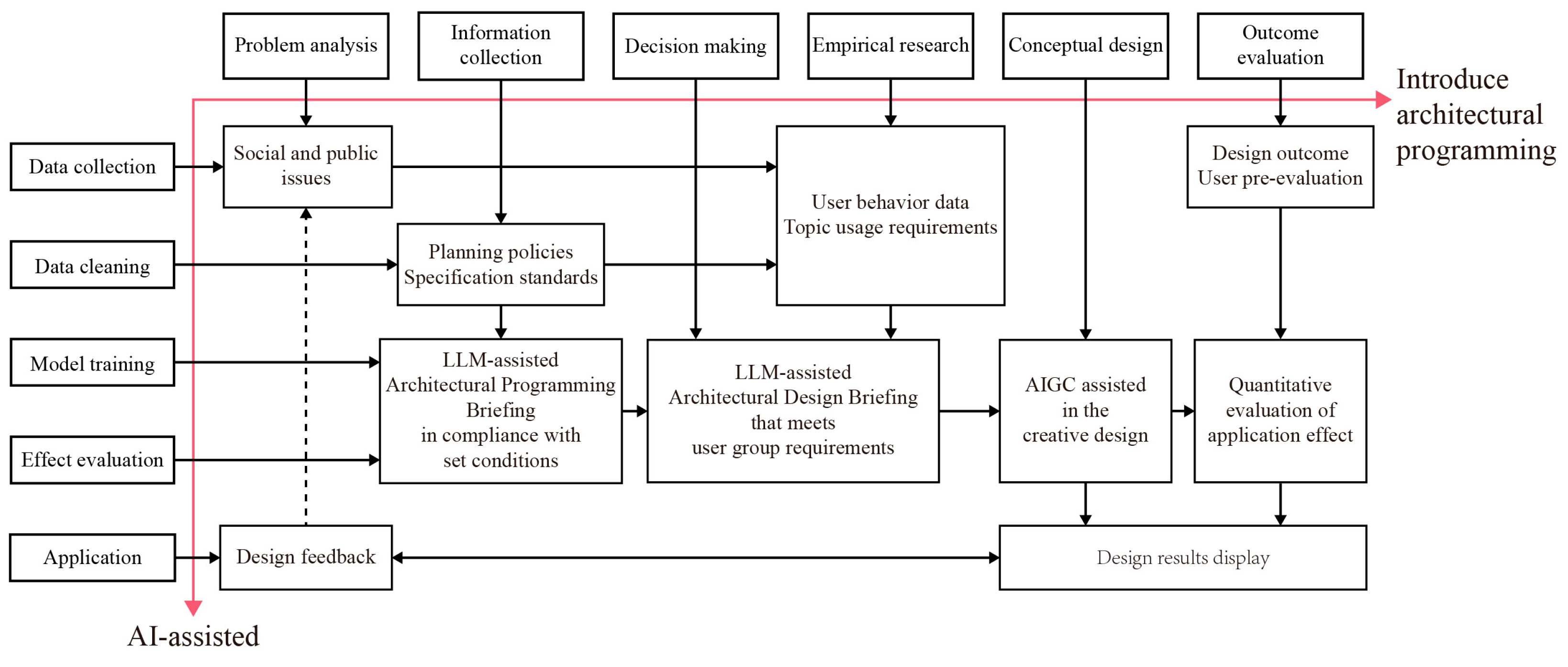
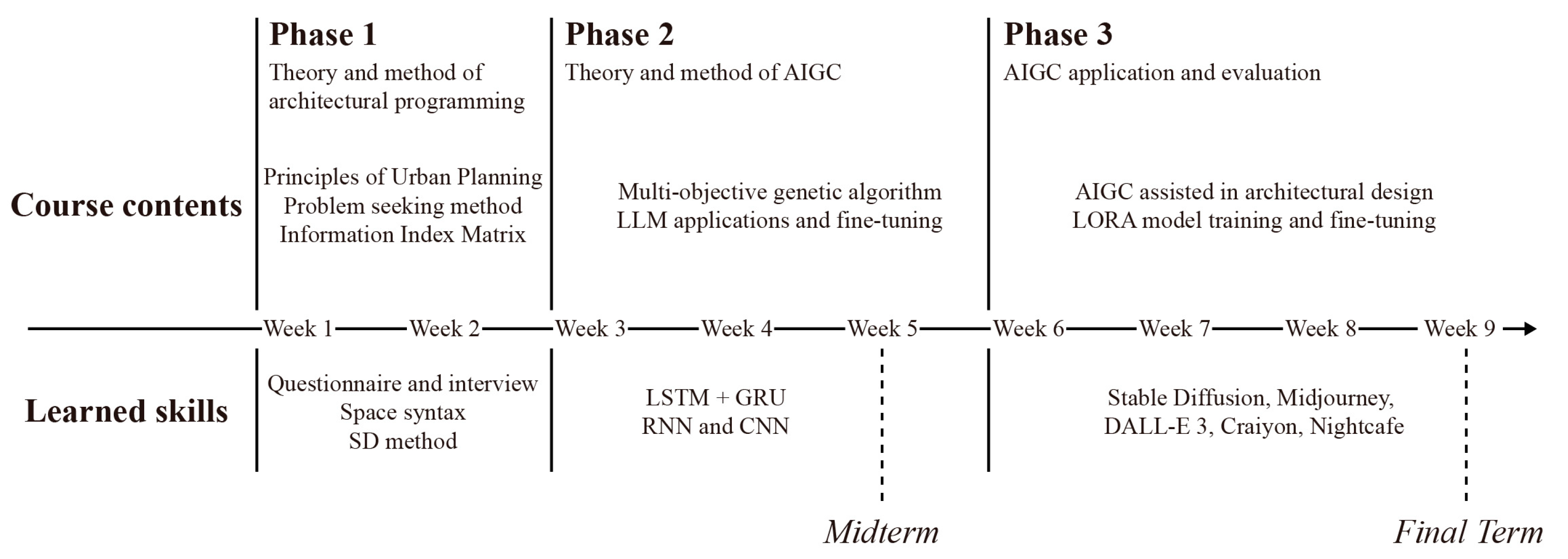
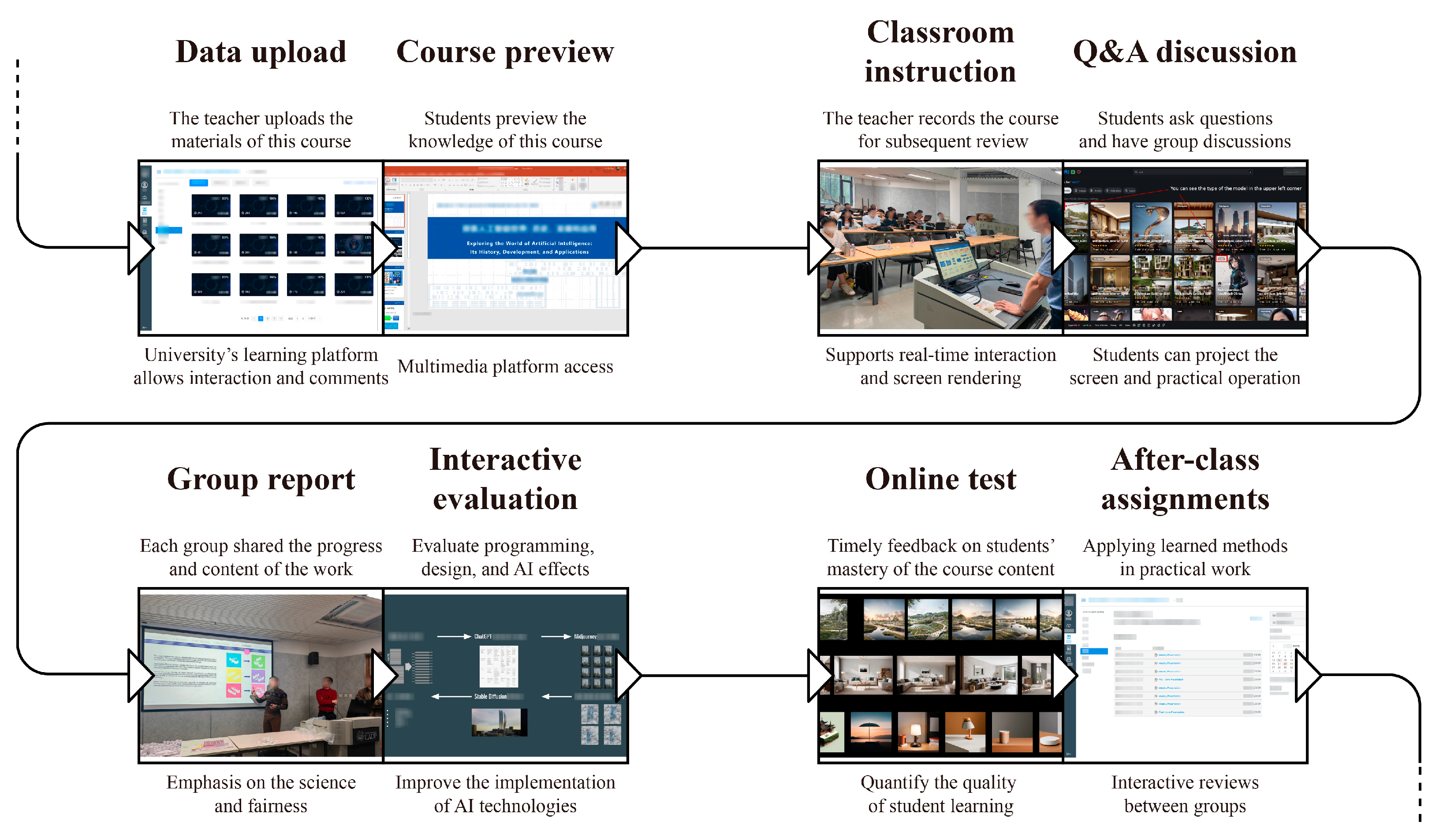
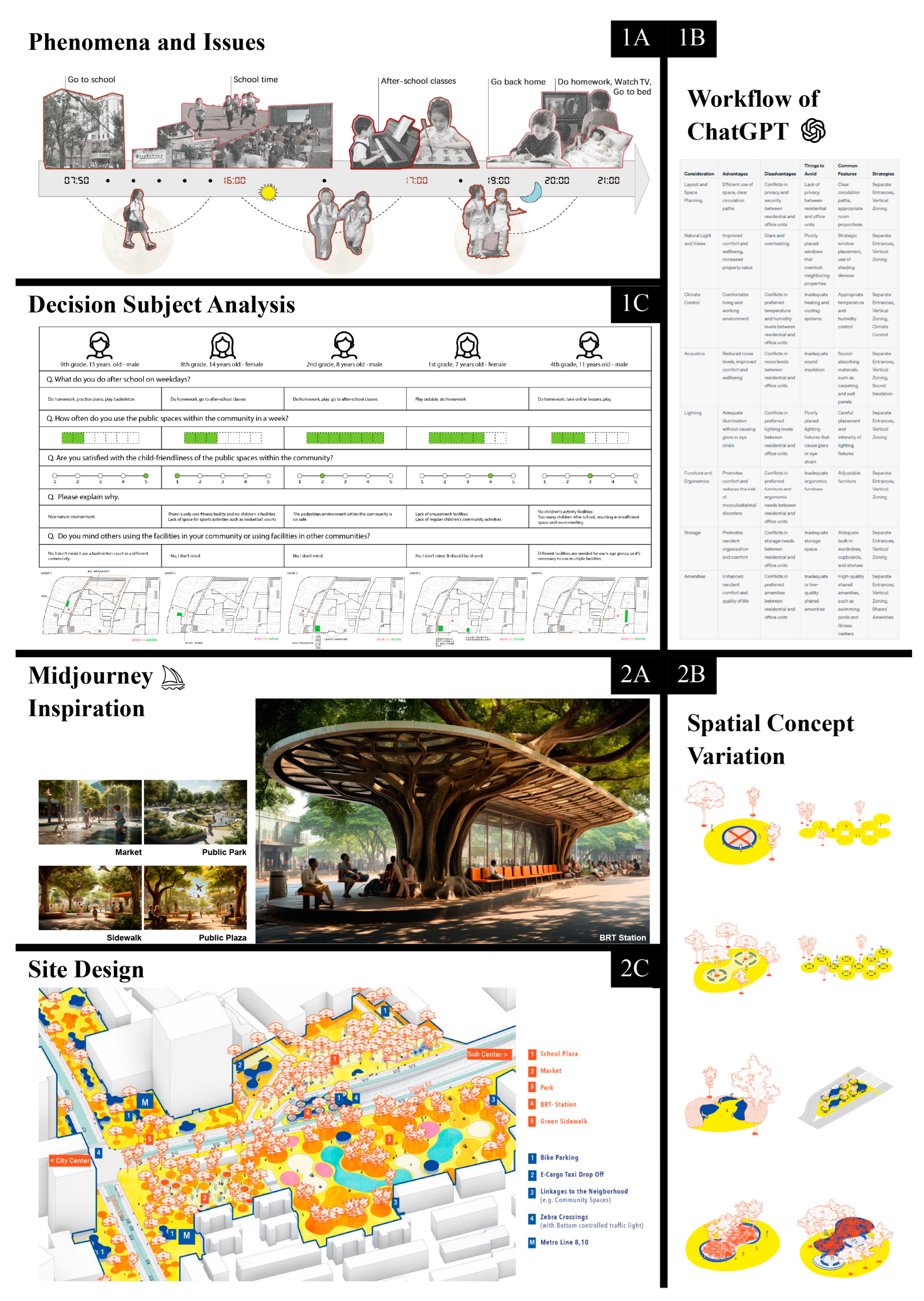
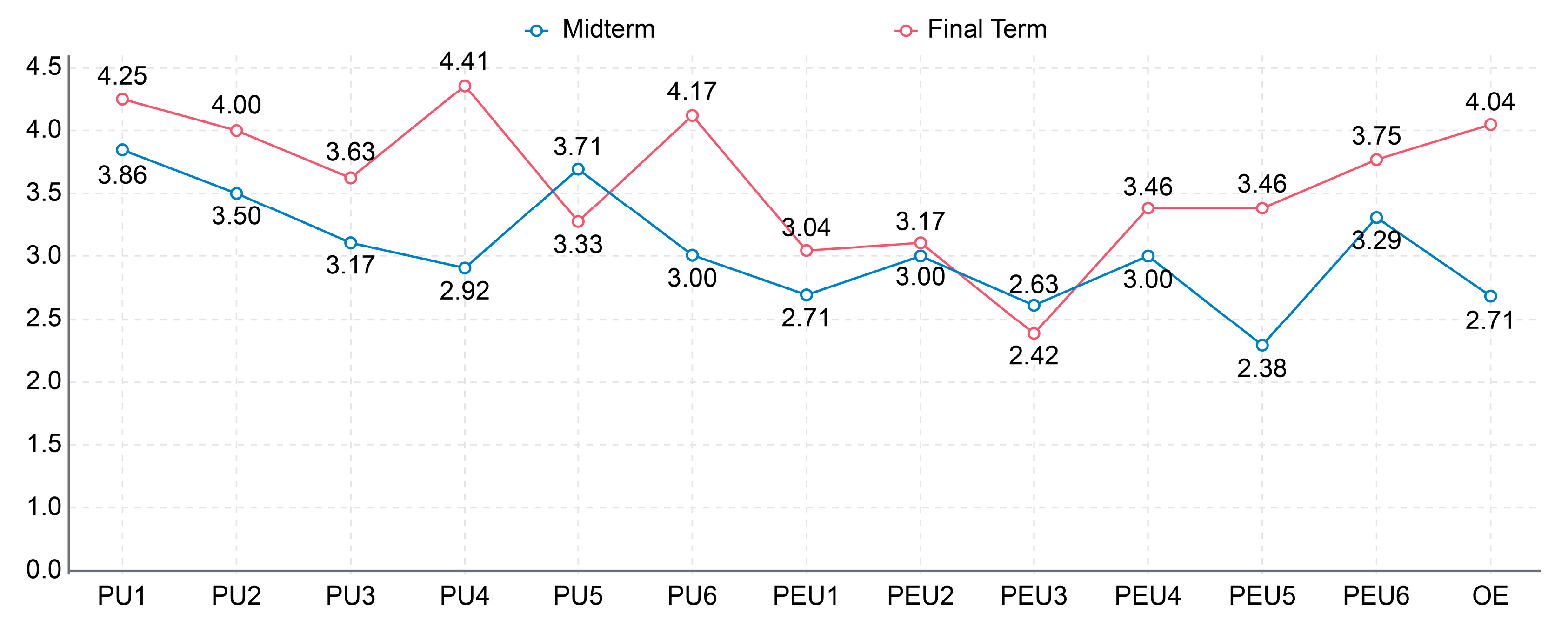

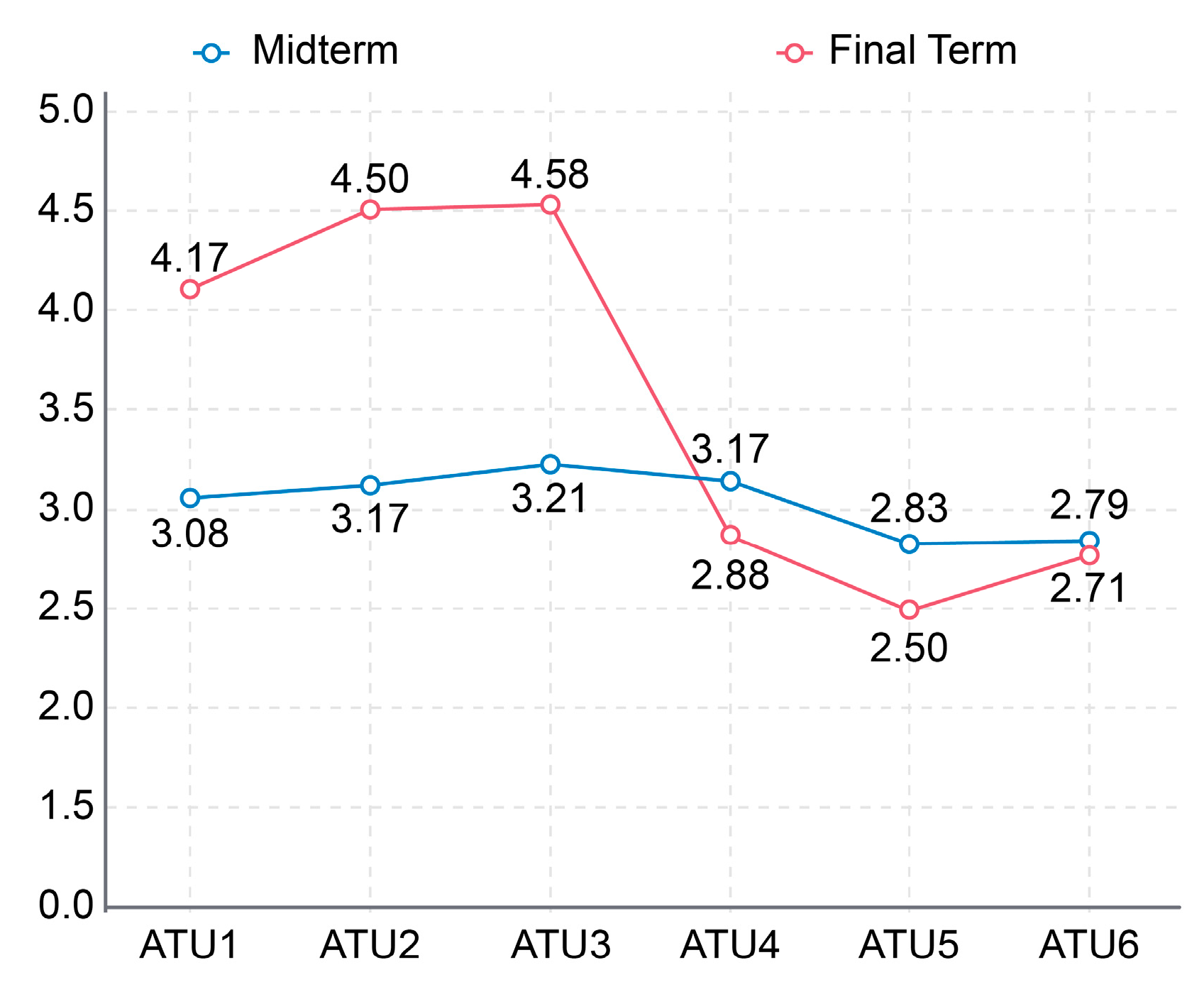
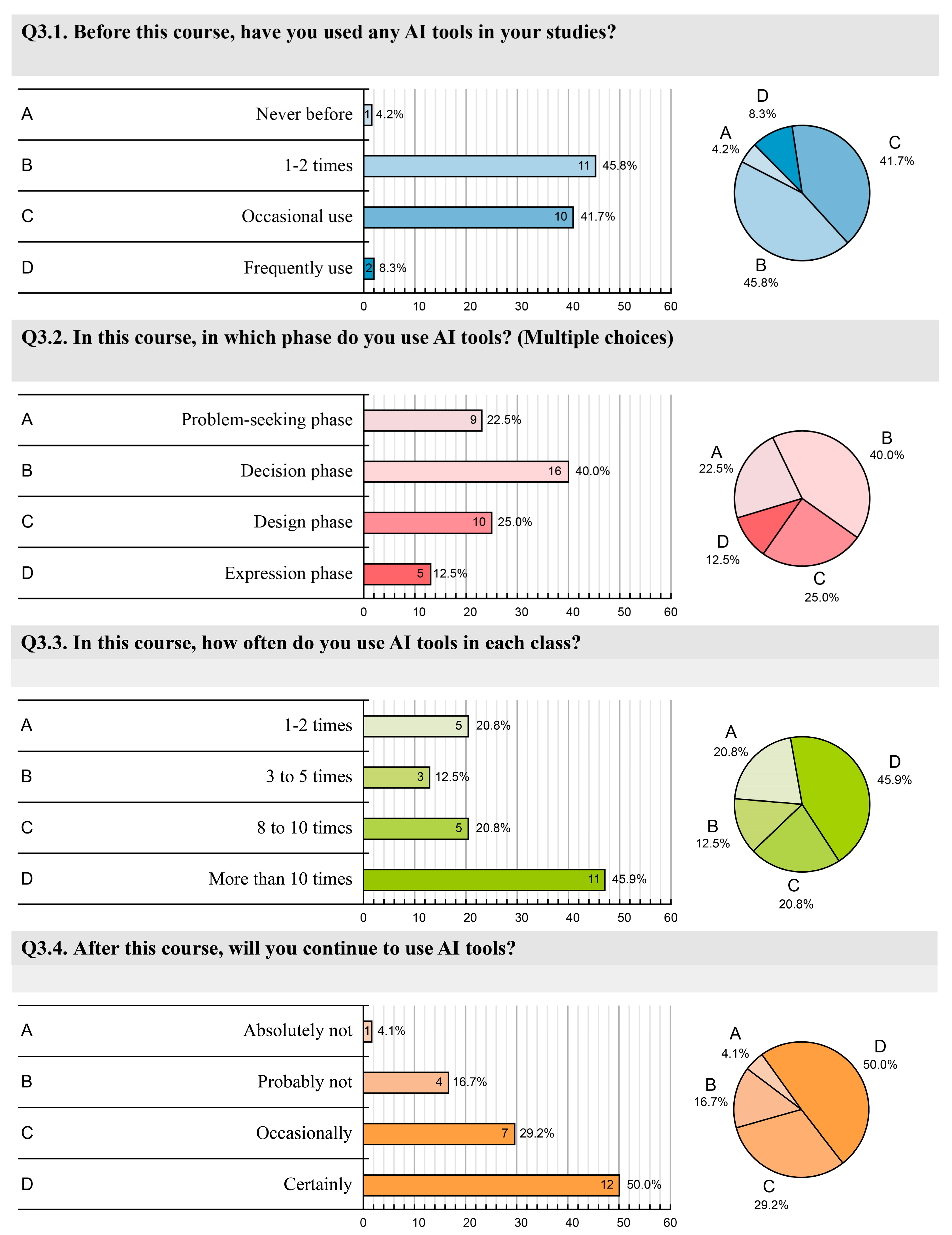

| Attributes | Distribution | Respondents % (n = 24) |
|---|---|---|
| Gender | Male | 73% (10) |
| Female | 27% (14) | |
| Education level | Undergraduate students (Year 3 and Year 4) | 35% (6) |
| Master’s students | 64% (18) | |
| University |  | |
| Cronbach’s alpha | 0.919 | |
| Kaiser–Meyer–Olkin Measure of Sampling Adequacy | 0.757 | |
| Bartlett’s Test of Sphericity | Chi-squared | 175.563 |
| Degrees of freedom | 78 | |
| p-value | 0.000 | |
| Variable | B | Standard Error | Beta | T-Value | Significance |
|---|---|---|---|---|---|
| (constants) | 1.835 | 0.879 | 2.087 | 0.091 | |
| PU1 | −0.600 | 0.283 | −0.576 | −2.122 | 0.087 |
| PU2 | −0.158 | 0.106 | −0.156 | −1.496 | 0.195 |
| PU3 | 0.568 | 0.149 | 0.705 | 3.807 | 0.013 |
| PU4 | 0.679 | 0.151 | 0.620 | 4.505 | 0.006 |
| PU5 | 0.336 | 0.166 | 0.449 | 2.027 | 0.098 |
| PU6 | −0.740 | 0.235 | −0.720 | −3.147 | 0.025 |
| PEU1 | −0.448 | 0.216 | −0.596 | −2.075 | 0.093 |
| PEU2 | 0.167 | 0.302 | 0.227 | 0.553 | 0.604 |
| PEU3 | −0.135 | 0.180 | −0.150 | −0.753 | 0.486 |
| PEU4 | −0.293 | 0.455 | −0.333 | −0.644 | 0.548 |
| PEU5 | 0.820 | 0.177 | 1.178 | 4.620 | 0.006 |
| PEU6 | 0.418 | 0.221 | 0.453 | 1.894 | 0.117 |
| ATU1 | −0.255 | 0.278 | −0.240 | −0.917 | 0.401 |
| ATU2 | 0.044 | 0.499 | 0.033 | 0.088 | 0.934 |
| ATU3 | −0.305 | 0.634 | −0.231 | −0.481 | 0.651 |
| ATU4 | 2.402 | 0.839 | 1.534 | 2.862 | 0.035 |
| ATU5 | 0.113 | 0.169 | 0.081 | 0.670 | 0.533 |
| ATU6 | −1.794 | 0.877 | −1.247 | −2.045 | 0.096 |
| R = 0.990 | R2 = 0.979 | Adjusted R2 = 0.905 | |||
| Positive Attitude | Negative Attitude |
|---|---|
| “GPT is convenient and effective in problem analysis” | “The image generation process of SD is unpredictable” |
| “AI provides logicality for programming” | “SD’s generation process is like drawing cards” |
| “ChatGPT thinks comprehensively” | “Very complex, tuning parameters is mysterious” |
| “AI guides me in data processing” | |
| “AI has strong logical and innovative capabilities” |
| Quantitative Research Methods | Qualitative Research Methods | Research Findings |
|---|---|---|
| descriptive statistics of Likert scale | one-on-one structured interviews | The AI-assisted architectural programming and design teaching model has a positive impact on student learning. |
| linear regression analysis of Likert scale | The “innovative thinking ability” and “work efficiency” of AI tools are significant factors affecting students’ overall effectiveness evaluations. | |
| descriptive statistics of Likert scale | one-on-one structured interviews, content coding analysis of interview transcripts | Students hold positive attitudes when using AI tools in the architectural programming stage, but encounter challenges and limitations when using AI tools in the architectural design stage. |
| statistical analysis of single-choice questions | one-on-one structured interviews | Most students are willing to use AI tools in architectural creation in the future. Currently, students only use AI tools partially, failing to form a comprehensive AI-assisted architectural working methodology system throughout the process. |
Disclaimer/Publisher’s Note: The statements, opinions and data contained in all publications are solely those of the individual author(s) and contributor(s) and not of MDPI and/or the editor(s). MDPI and/or the editor(s) disclaim responsibility for any injury to people or property resulting from any ideas, methods, instructions or products referred to in the content. |
© 2024 by the authors. Licensee MDPI, Basel, Switzerland. This article is an open access article distributed under the terms and conditions of the Creative Commons Attribution (CC BY) license (https://creativecommons.org/licenses/by/4.0/).
Share and Cite
Jin, S.; Tu, H.; Li, J.; Fang, Y.; Qu, Z.; Xu, F.; Liu, K.; Lin, Y. Enhancing Architectural Education through Artificial Intelligence: A Case Study of an AI-Assisted Architectural Programming and Design Course. Buildings 2024, 14, 1613. https://doi.org/10.3390/buildings14061613
Jin S, Tu H, Li J, Fang Y, Qu Z, Xu F, Liu K, Lin Y. Enhancing Architectural Education through Artificial Intelligence: A Case Study of an AI-Assisted Architectural Programming and Design Course. Buildings. 2024; 14(6):1613. https://doi.org/10.3390/buildings14061613
Chicago/Turabian StyleJin, Shitao, Huijun Tu, Jiangfeng Li, Yuwei Fang, Zhang Qu, Fan Xu, Kun Liu, and Yiquan Lin. 2024. "Enhancing Architectural Education through Artificial Intelligence: A Case Study of an AI-Assisted Architectural Programming and Design Course" Buildings 14, no. 6: 1613. https://doi.org/10.3390/buildings14061613
APA StyleJin, S., Tu, H., Li, J., Fang, Y., Qu, Z., Xu, F., Liu, K., & Lin, Y. (2024). Enhancing Architectural Education through Artificial Intelligence: A Case Study of an AI-Assisted Architectural Programming and Design Course. Buildings, 14(6), 1613. https://doi.org/10.3390/buildings14061613










